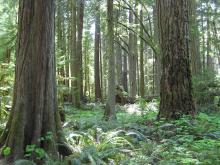
Tropical and Temperate Forests Are More Similar Than Previously Believed, Scientists Say


The temperate forests of Canada or Northern Europe may have much more in common with the tropical rainforests of Southeast Asia or South America than previously believed, according to a research group sponsored by UC Santa Barbara's National Center for Ecological Analysis and Synthesis (NCEAS).
The findings are published this week in the journal Science. The authors focused on the concept of "beta-diversity," a measure of the change in species composition between two sites, such as neighboring patches of forest. High beta-diversity means that two given sites have few species in common.
Typically, beta-diversity increases as one moves from the poles toward the equator, which has caused many ecologists to conclude that there is something inherently different about the ecology of the tropics that leads to greater turnover of tropical species from place to place.
The NCEAS team challenged this interpretation, using an extensive dataset of tree inventories from around the world, archived at the University of Arizona. Using computer modeling, they demonstrated that current patterns of beta-diversity, both in the tropics and the temperate zone, are much more similar than ecologists once thought.
"This study demonstrates how new insights into ecological communities can be found when synthesizing and re-examining existing datasets that have been made publicly available," said Liza Comita, second author and assistant professor at Ohio State University. Comita recently completed a postdoctoral fellowship at NCEAS.
The researchers found that the crucial factor in shaping beta-diversity at large scales is the number of species present in the region in the first place. Once they accounted for these differences, the resulting beta-diversity patterns were the same in forests at tropical and temperate latitudes. They also found the same consistency between high and low elevations in mountain regions.
"It was believed that something ‘extra' must be going on in the ecology of the tropics to produce greater beta diversity there," said Nathan J.B. Kraft, first author and postdoctoral fellow at the University of British Columbia's Biodiversity Research Centre. "We now see that the patterns can all be explained, not by current ecological processes unfolding over one or two generations, but by much longer-term historical and geologic events.
"We were surprised to see that the causes of these patterns might actually be a lot more simple, and share a lot more in common, than we first thought," said Kraft. "For decades now, ecologists have gone to the tropics to try to explain the often incredibly high diversity found there. But what our results show is that the same ecological mechanisms might operate in similar ways in Costa Rica and Calgary."
The research group included scientists from institutions in the U.S., Canada, Panama, and New Zealand.
The National Science Foundation is the primary funder of NCEAS.
Related Links



